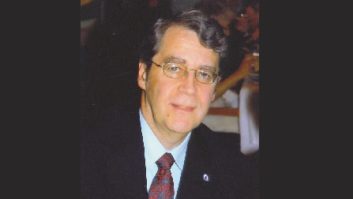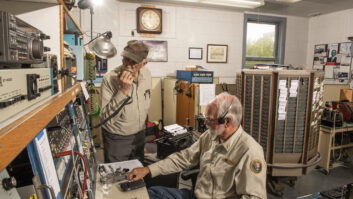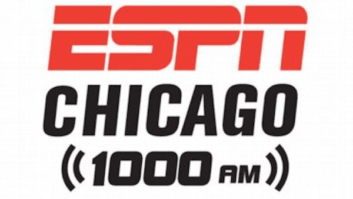
Fig. 1: Take note of the wiring colors inside your electric panels. Charles S. “Buc” Fitch, P.E., was reminded of the issue of electrical wiring color code a few days ago. He opened a panel and found the entire “hot/phase” side wired in black wire. This doesn’t help the tasks of load balancing and maintenance.
Although the National Electrical Code doesn’t require a specific color code for ungrounded conductors, electricians often use the following color system for power and lighting conductor identification:
• 120/240V, single-phase wiring — black, red and white
• 120/208V, three-phase wiring — black, red, blue and white
• 120/240V, three-phase wiring — black, orange, blue and white
• 277/480V, three-phase wiring — brown, orange, yellow and gray; or, brown, purple, yellow and gray
On the grounded side for neutrals, the wires have to be white or gray. Buc prefers white at 120/240 (208) and gray for 277/480 circuits. Green or bare wire is always the grounding conductor.
Personally, Buc specifies the latter 277/480 color grouping; that removes the “orange” wire color and any confusion. Why? Orange is the only specified ungrounded conductor and marks the “wild leg” of a 120/240 center-tapped neutral delta configuration. For those unfamiliar: In wild leg configuration, the two end phases on the center-tapped winding provide 120 volts to neutral, but on the wild leg you will find nearly 208 volts to the neutral.
If you see an orange wire in a panel, alarm bells of caution should go off in your head. You don’t want to wire a 120 VAC outlet across the wild 208 volt phase.
* * *
Previously we solicited feedback on the use of those laser-sighted infrared thermometers.
Dave Doherty of Skywaves has a Fluke 62. It has a 10:1 ratio and claims accuracy to within 1 percent. Dave can testify that it works great in high RF AM environments like that of 50 kW WCRN.
Dave has not tried it in a high-RF FM or TV environment. The instrument works fine at Rhode Island’s WBRU(FM) and WHJY(FM), though the FM RF level in the building is low there.
What have you experienced? Write to me at [email protected].

Fig. 2: White LED magnifiers make troubleshooting easier. These are useful devices for spotting overheated components. Dave writes he’s also used long tie-wraps to keep J-plugs in place inside AM ATUs and phasors. That won’t keep them from burning if the connections are loose, but he uses the Fluke to keep an eye on that.
The meter also is useful for checking the heat on those Lapp insulators — before messing with the drain holes. (Dave loved the idea about putting foam peanuts inside the insulators. It’s just too bad you have to shore up the tower and disassemble the insulator to do it!)
* * *
And speaking of those foam peanuts, Cumulus Boise Engineer Bill Frahm liked the idea of putting a few foam packing peanuts inside a new base insulator to give any water a place to expand, should the drain holes become clogged and the water freeze.

Fig. 3: Another brand of LED magnifier. But … Bill cautions to choose your peanuts wisely. Don’t use the ones that are “eco-friendly” — sorry, but they will disintegrate when wet.
* * *
From Kuala Lumpur comes a neat idea from engineer Paul Sagi. He found the white LED-lighted magnifier keychain assemblies, pictured in Figs. 2 and 3, which cost him less than $4 each. Use your search engine to track these down; you’ll have lots of choices.
* * *
Townsquare Media’s Andy Soule commented on our discussion about the use of plastic pill bottles. Andy writes that he quit smoking last year using nicotine lozenges. The lozenges come in packs of four blue bottles; each one has a small silica capsule in it to absorb moisture.
Andy found the silica capsules handy and used dozens for this purpose. He tosses extra desiccants into toolboxes, drawers, anywhere they can help.
The little blue bottles weren’t thrown away, either — Andy had so many of them that he used them with some duct tape to make a ladder line for a makeshift ham radio antenna.
Contribute to Workbench. You’ll help your fellow engineers and qualify for SBE recertification credit. Send tips to [email protected]. Fax to (603) 472-4944.
John Bisset has spent 43 years in the broadcasting industry and is still learning. He is SBE certified and is a past recipient of the SBE’s Educator of the Year Award. He works for Elenos USA.












